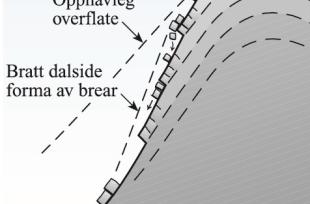The bedrock in Ulvanosa and the whole massif westward to Englafjell Mountain and Mannen was formed when a granitic magma hardened to stone by an enormous rock pressure 15–20 kilometres beneath the earth's crust. This happened about a billion years ago. When the land got eroded away and the crust rose toward the surface, the pressure grew less. This caused the bedrock to spread out and fracture parallel to the surface - like the layers of an onion. These fractures contribute to the round forms that we see today. But, as so many other places, also what happened under the ice ages is important for understanding the land forms.
For long periods under the ice ages the tops of Ulvanosa were ice-free. The snow that blew down from The plateau collected in the valleys on the eastern side, and during periods formed small, steep hanging glaciers down toward the upper part of Uskedalen valley. The glaciers initially carved out round, trough-shaped cirques from the valley side. Eventually, as the bottom glaciers carved in, the slopes got steadily steeper. The "onion fractures", that ran parallel with the earlier valley side, were crossed by the newer and steeper valley side. In the fractures frost shattering was active, and edges with steep overhangs were formed. The snow that collects in the steep snowdrifts along the side of the plateau, races down when the temperatures rise in the spring. Avalanches tear loose stone and blocks along the fractures and transport them down to the valley bottom, where they build up big fans of rockslide material.
That they are cirques, we see by the sharp edge near the transition between the plateau and the valleys that lie in systematic rows from north to south: Geitadalen, Kolkjeredalen, Øktaredalen and the valleys on either side of Litlenuten. The two first valleys and the ridges between them are nicely rounded. It is clear that it is "onion fracturing" that has given them their rounded forms. From below, the ridges between them look like a sugarloaf, but toward the top they still have sharp edges.

